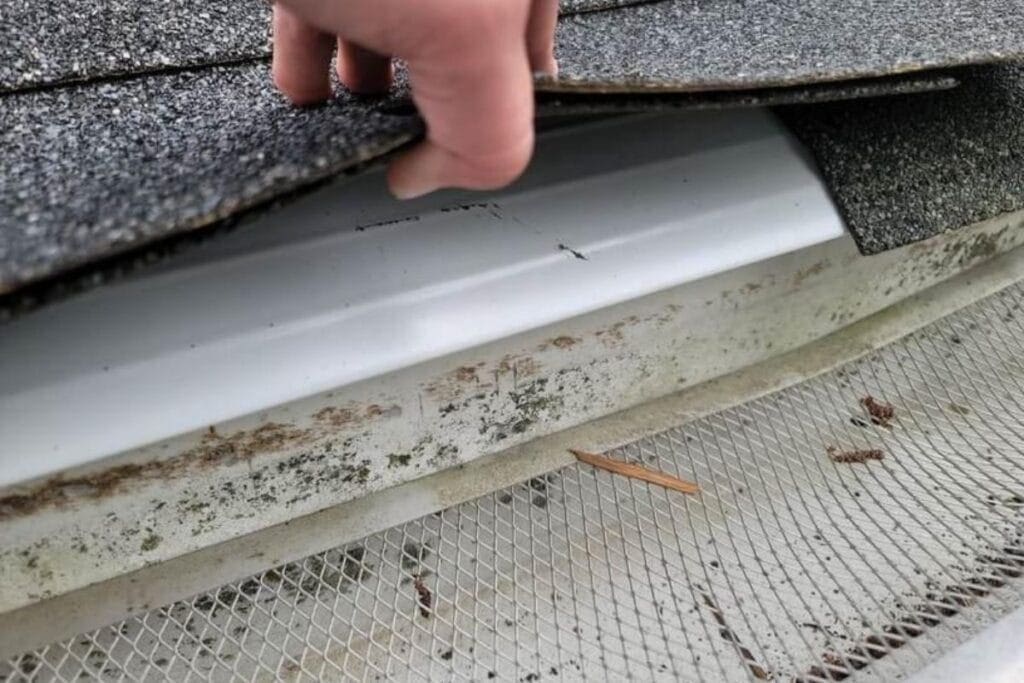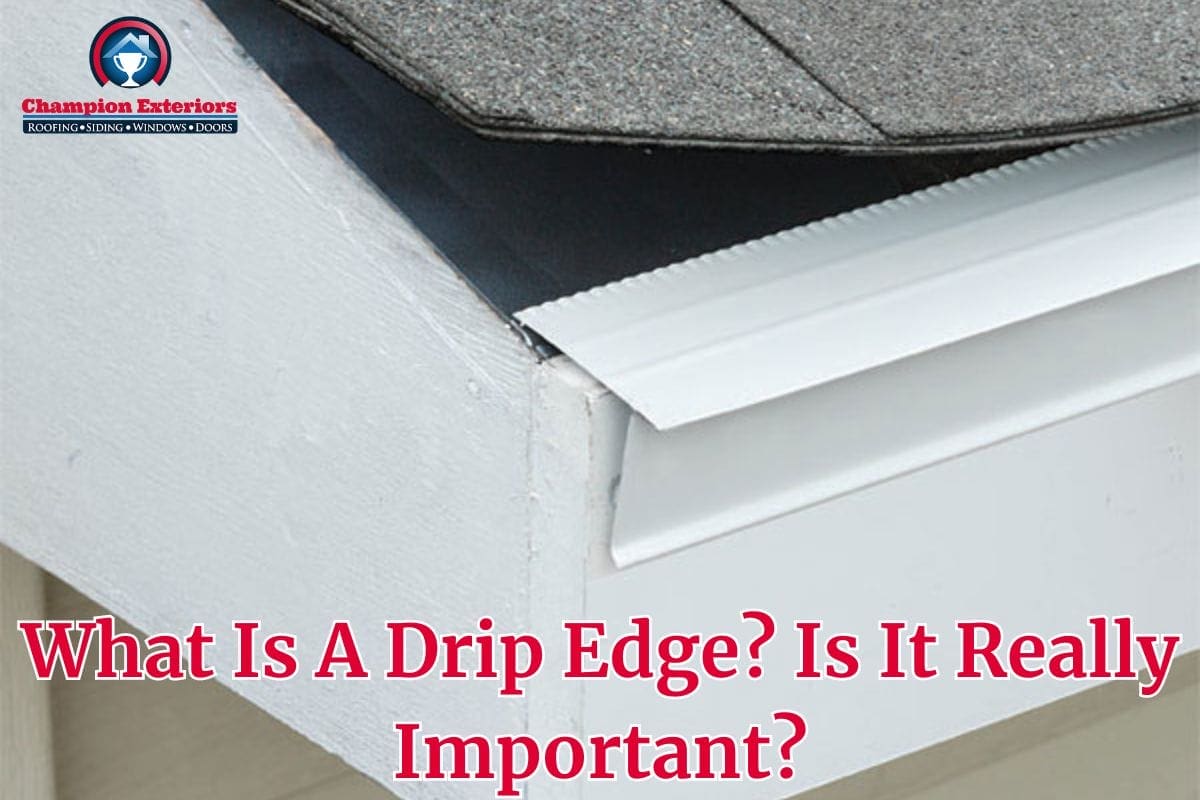Drip edges are essential parts of any roof and need proper installation and repair work by a professional. If you are getting a new roof or fixing the damaged parts of an old one, this guide on roof drip edges is all you need. In this blog post, we’ll uncover what exactly a drip edge is, how it functions to shield your home, and why mishandling or skipping this element could spell trouble for your roof’s strength and ability to function.
What Is A Roof Drip Edge?

Even if you’re unfamiliar with roofing terminology or are taking the first steps to understand how roofing systems work, knowing about the importance of smaller components like the drip edge is crucial and could save you money on future repairs.
A drip edge is a kind of metal flashing mounted along the edge of your roof. Its primary design is to control the flow of water away from underlying roofing components and ensure that runoff doesn’t sneak its way underneath your shingles, where it can cause rot or water damage. But what makes them indispensable parts of a roofing system isn’t merely their ability to guide water, it’s the aesthetic value they bring to a roof, making it look neat and trim.
What Is The Purpose Of A Drip Edge?
Ignoring proper installation or skimping on quality when it comes to selecting a suitable drip edge can have numerous effects on the longevity and health of your home’s roofing system:
👉Prevents Water Damage
At the core of its function, drip edge flashing serves as a strong barrier to water infiltration. By nature, water seeks the path that it can easily flow to, and without proper direction, it can seep into places that should remain dry. Drip edges are crafted to create a path that diverts water away from the vulnerable edges of a roof, where it would otherwise cause rot or mold along the decking, rafters, and ceilings of your home.
👉Directs Water Away From The Fascia And Soffit
Drip edge flashing ensures water flows away from fascia boards and soffits. Unfortunately, these roofing components are prone to water damage if they’re left unprotected. With drip edges installed along the margins of your roof, rainwater is channeled safely into gutters, keeping these components dry and intact throughout seasons riddled with rainfall.
👉Preserves Roofing Materials
We often overlook that the materials used for roofing, such as shingles, underlayment, and wood, are susceptible to nature’s wear and tear over time. Well-placed drip edge flashing acts like armor for the edges of these materials, which are particularly exposed to wind-driven rain or snow. This additional layer helps prevent premature deterioration by stopping water from getting underneath shingles, thus preserving the integrity of your entire roofing system.
👉Increases The Longevity Of The Roofing System
Ultimately, every aspect of a well-constructed drip edge contributes to extending the life expectancy of your roof. Whether it’s fending off water damage or protecting roofing materials against harsh weather conditions, these metal strips grant you peace of mind for years on end. This longevity adds financial and aesthetic value to your home by reducing long-term repair costs and maintaining your roof’s defensive strength against environmental challenges.
Materials Used To Make A Drip Edge
When it comes to protecting your roof from water damage, the material chosen for the drip edge is a crucial decision. Drip edge flashing can be made with various materials, each with its own set of strengths and suitability depending on the specifics of your roofing project.
#1 Aluminum
Aluminum stands out as a favored choice for many people installing drip edges. Its widespread popularity is attributed to several key factors:
- Corrosion Resistance: Aluminum naturally forms an oxide layer when exposed to air, providing protection against corrosion.
- Flexibility: It’s easier to shape and fit around different roof profiles, which makes installation less of a hassle.
- Lightweight: Being light means there’s less of a strain on your roofing structure.
- Cost-Effectiveness: Aluminum offers an affordable solution while still delivering enhanced durability.
Keep in mind that though aluminum doesn’t rust like steel might, it can corrode when it comes in contact with certain metals or acidic environments. Make sure there is compatibility with other roofing materials before choosing aluminum.
#2 Galvanized Steel
Galvanized steel drip edges are another robust option characterized by their protective zinc coating.
- Sturdy Protection: The zinc layer provides an excellent form of defense against corrosion and rust.
- Endurance: Galvanized steel stands up well over time, maintaining its integrity under harsh weather conditions.
- Affordability: Like aluminum, it’s also cost-effective without sacrificing performance.
One thing to note is that if the galvanized coating wears off over time, the steel underneath becomes susceptible to rust. Therefore, periodic inspections are recommended.
#3 Copper
Copper presents as a premium selection renowned not only for function, but also for aesthetic appeal as it develops a distinctive greenish patina over time.
- Longevity: Copper drip edges are incredibly durable, with some lasting upwards of a century.
- Low Maintenance: Unlike other metals, copper won’t rust or require painting.
While copper adds unrivaled elegance and has exceptional longevity, its higher price point may not align with all budgets, which makes it a luxurious choice compared to more economical alternatives.
#4 Vinyl/PVC
Vinyl or PVC drip edges offer unique benefits largely centered around versatility and ease of use.
- Variety of Colors: These come in numerous colors, allowing them to blend seamlessly with most shingles or siding colors.
- Simple Installation: Lighter and easy to handle, they allow for quick installation; even for DIY enthusiasts.
It’s worth noting that vinyl drip edges may lack the strength of metal options and could become brittle under extreme temperature fluctuations. Careful consideration based on climate should govern whether this is the right choice for you.
#5 Fiberglass Reinforced Plastic (FRP)
The FRP variety combines traditional drip edge solutions with enhanced qualities.
- Impact Resistance: The reinforced fibers grant superior resistance against physical impacts.
- Non-Corrosive Nature: Being plastic-based, they do not suffer from corrosion issues that affect metal alternatives.
Despite these advantages, FRP can still be sensitive to ultraviolet light, which may result in degradation over long periods of time, unless it is specifically treated with coatings that protect against UV rays.
When deciding upon what material best supports your needs, consider factors such as longevity requirements, local weather patterns, and aesthetic preference alongside economic constraints. After choosing a material, you need to finalize the profile of the flashing piece.
Different Types Of Drip Edge Profiles
Shapes are not just about aesthetics. The difference in a drip edge profile comes with a difference in its performance.
#1 L-Style (Type C)
The L-style, also known as type C, is one of the most common drip edge profiles used in residential roofing. This profile features a 90-degree angle resembling the letter L. There are flanges on both sides with one flange fighting under the roofing materials while the other extends out towards the gutters.
This simple yet effective shape is ideal for channeling water directly into the gutter system without allowing it to creep back underneath roofing materials. The simplicity of its shape makes it easy to install, so it’s a popular choice among contractors and homeowners.
#2 T-Style (Type D)
A T-style or type D drip edge includes an additional downward protrusion along the exterior edge, forming a T shape. It provides added protection against wind-driven rain by extending past the fascia board.
This design is particularly beneficial for areas prone to severe weather as it offers an extra layer of defense against water infiltration along roof edges. By ensuring that water flows further away from your home’s siding and foundation, Type D profiles actively reduce the chance of moisture-related complications over time.
#3 Type F
Characterized by a longer flange than either type C or D, this flashing profile is commonly referred to as a gutter apron due to its compatibility with gutter systems. It is engineered with a flare-out design that directs more water into gutters, even during heavy rainfall.
The extended length of this profile allows for more flexibility when dealing with different sizes and styles of gutters and eaves.
Regardless of your preference, remember that proper installation is key to ensure these components offer maximum benefit to your home’s roofing system throughout its lifespan.
Best Practices And Tips For Drip Edge Installation
The integrity of your roofing system heavily depends on the proper installation of components like drip edges. By adhering to some best practices, you can ensure that this important part of the roof not only looks visually appealing, but is also functional.
👉Selecting A Reliable Local Roofing Contractor
The first step is to hire a professional who is experienced in residential roofing and operates in and around the town. The contractor should hold the necessary licenses and certifications for authenticity. Their team should also have a successful record and a high number of positive reviews and ratings from previous customers.
👉Choosing The Right Size And Material
Size is just as critical as material choice. The drip edge should extend far enough over the gutter to prevent water from slipping behind it. Additionally, the roofers should consider the pitch of your roof when choosing a size, as steeper roofs may need wider drip edges.
👉Proper Alignment And Overhang
A perfect drip edge placement involves aligning the metal flange flush with the edge of the roof deck. Too much overhang could result in bending or breaking under heavy winds, while too little won’t properly guide water into gutters. Typically, an overhang of half an inch past the deck’s edge is recommended. Make sure your roofing contractor adheres to local building codes, which might dictate the specific requirements you’ll need to follow.
👉Using Fasteners And Sealants
Securing the drip edge requires using the appropriate fasteners, such as roofing nails or screws designed for exterior use. These should penetrate deeply enough into the roof deck and framing for a firm hold without puncturing through completely. The application of a sealant is also essential along edges where different pieces meet or overlap so that no leaks form at joints or seams.
👉Ensuring Proper Connection At The Corners
Corners demand special attention as they’re prone to gaps if not connected correctly. Any installation by an inexperienced roofer or unauthorized handyman can create entry points for water damage later on. To elegantly handle corners, they need to trim each end of adjoining pieces at a 45-degree angle so they fit snugly together, forming a tight miter joint.
We hope this information serves as a valuable resource for you to get started with your roofing project. If you are looking for professional guidance or a roof repair service in South Jersey, our experts are here to guide you.
Discuss Your Roof Repair & Replacement Needs With South Jersey’s Expert Roofing Professionals!
At Champion Exteriors, we’ve been upgrading residential roofs in the area for many years. Countless homeowners trust our experts and praise them for their quick, efficient, and tidy roofing services. If you are looking for drip edge or more roof repair services in South Jersey, we’re here to help. Call us at (800) 276-0032 and schedule a free roof consultation with one of our experts.


